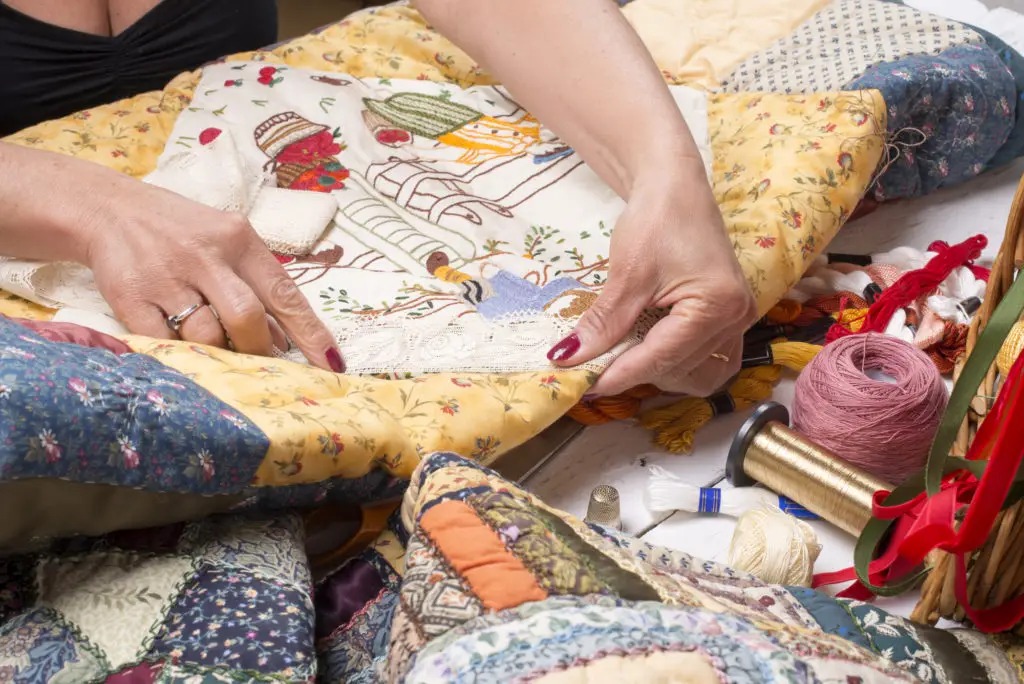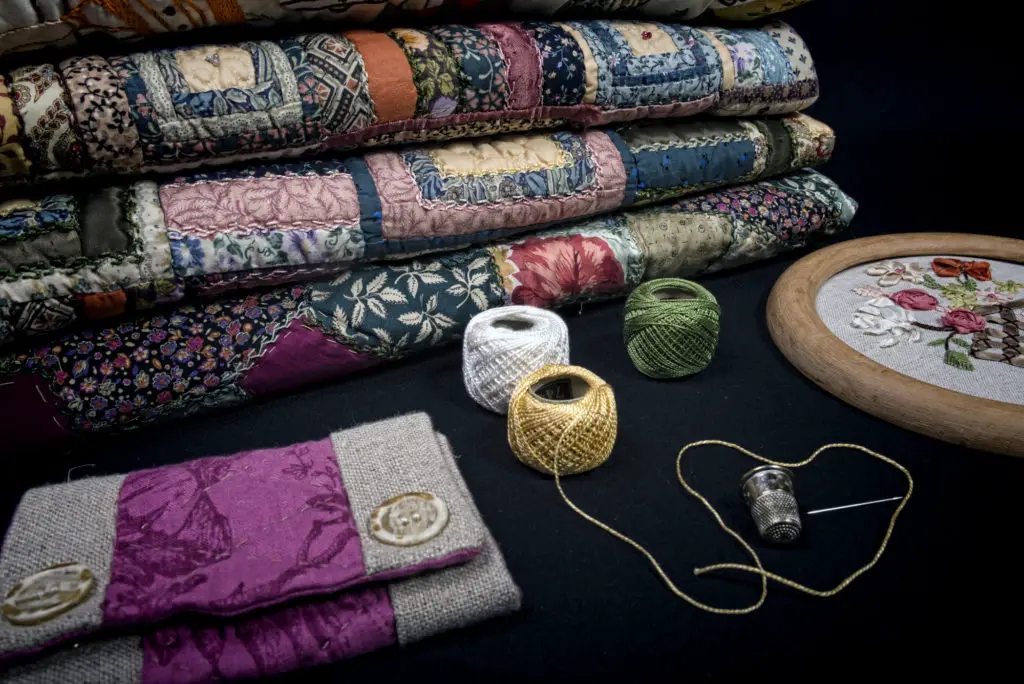How Much Does It Cost To Make A Quilt?
Over thousands of years, quilting has evolved and changed, but one thing remains the same, people love it! It is a fun hobby that millions of people of all ages enjoy. If you are new to the quilting scene, you may be wondering if it is worth all this fuss. Well, in this article we are going to give you a quick rundown of the tools and supplies you will need as well as a general idea of the cost of making a quilt.
How Much Does It Cost To Make A Quilt? It varies widely, but a quilt can be made for as little as nothing utilizing materials that you already have at home up to hundreds of dollars depending on the choices you make in fabric and other materials.

Sound confusing? That’s okay, what we can do is give you the information you need to formulate a general idea of what you might be spending based on your quilting plans and preference. Let’s get started!
How Do I Get Started Quilting? Classes, Materials and Expenses
What Supplies Will I Need To Make A Quilt?
Pattern
The first thing you need when you are going to make a quilt is a pattern. There are thousands of patterns available from many sources, both for purchase and for free. A quick online search can provide a lot of inspiration as well as bring up artists who have patterns for sale.
These patterns can range from $1.99 to $100, depending on the design creator and pattern complexity. If you are making an heirloom quilt, or you have a particular design in mind, it would be worth looking into these patterns.
If you are a beginner or you are looking for something less complex, then you may want to check into the thousands of free patterns online. You can also find quilting books at your local library if you would prefer to have a book to follow.
Tools
Quilting tools are also called notions, and we have a guide to the different notions you may need for your quilt right here.
The number of tools you need will depend on the pattern you choose, but there are a few basic tools you will definitely need (Note that these prices are generalized and you may be able to find some products for less):
- Sewing Machine ($89.00 and Up)
- Scissors ($1.00 – $29.99)
- Seam Ripper ($0.99 – $14.99)
- Iron ($8.99 – $49.99)
- Ironing Board ($7.99 – $49.99)
A few other helpful, but not absolutely necessary, tools would include:
- Cutting Board ($9.99-$49.99)
- Rotary Cutter ($8.99 – $19.99)
- Flat Ruler ($6.99 – $29.99)
- Washable Marking Pencil ($0.99 – $2.99)
- Angled Ruler ($6.99 – $49.99)
There are many good budget options available if you do not want to invest a lot of money. Just keep in mind that the price can reflect the quality of the tool, so buying the absolute cheapest option may not benefit you. In the same light, buying the most expensive product is probably not the right choice either.

Unless you are planning on making quilts professional, you most likely will never need a $50 pair of scissors. Something in the $15 dollar range will be perfectly sufficient. The same can be said of most of these supplies, if you choose items towards the middle of the price ranges, you should be fine. A little time and research should help you find good tools within your price range.
Materials
Fabric is one of the most costly elements of making a quilt, but it is also one of the most important. You can get by with inexpensive scissors or a smaller ruler, but you will want to be very careful about the fabric you choose. The best fabric to use for quilting is 100% cotton, which you can find at quilt shops and most of the larger fabric sellers.
As you start to look around you will begin to notice that there are definitely differences in quality between brands, so be careful. Make sure you choose fabric that is not too thin or cheaply made. You can find good fabric at lower prices when you go to a big box store, you just have to know what you are looking for.
Check Out Our List Of Fantastic Online Quilting Supply Stores!!
A good way to learn is to go to your local quilt shop and actually get a feel for the fabric. Even though all the quilting fabric should be 100% cotton, you will be able to feel the differences between brands.
Like the other products we mentioned, fabric can vary in price. You can find prices anywhere from $1 to $19.99 a yard. Again the quality varies with the price, but you do not have to purchase the most expensive fabric to make a beautiful quilt.

Shop around and see what you can find in your area, or if you already know of a brand that you like, you can also purchase your fabric online and often find good discounts. Keep in mind that even high-quality fabrics can shrink a little as well as lose a little dye, so it is a good practice to wash your fabric before you begin cutting out the pieces for your quilt top.
Do not forget that you will also need thread, batting, and backing fabric for your quilt. You can use regular all-purpose thread to sew your quilt top together. You can find quality thread just about anywhere that quilting supplies are sold and it usually starts at about $3.50 a spool. If you design to hand quilt your quilt, you will want quilting thread which can start at $2.50 a spool.

Batting, the padding between the quilt top and backing, can also be found at all fabric stores. The price ranges according to size, brand, and material. If you choose to have your quilt professionally quilted, the quilter will probably offer a variety of different types of batting and they can help you choose the best one for your project.
For the back of the quilt, you can buy backing fabric by the yard, just like the fabric you bought to make the top, only wider. It can come in widths as big as 108”, so you can have one solid piece of fabric for the back. A slightly less expensive option would be to simply buy a flat sheet.
You can get them at any bedding store and they come in a variety of colors and sizes, so you shouldn’t have a problem finding one to match your quilt. Do keep in mind that if you are taking your quilt to a professional quilter to be finished, the backing will have to be bigger than your quilt top, so make sure you contact them for the correct sizing.
Time
The amount of time you are going to spend on this project is also something to consider. Making a quilt top can take anything from a few hours to a few months, depending on your proficiency and the complexity of the pattern.
As we mentioned at the beginning, this is an art form so it can take some practice to perfect. If you enjoy sewing and do this for a hobby, then the time spent will be well worth it.
If you want to sell quilts, then your time should be a serious consideration. Many jobs pay by the hour because time is valuable. If you are making a quilt to sell, you have to consider the hours you spend building it as hours of work and charge accordingly. Also keep this in mind if you are buying a quilt from someone else, their time is valuable too.
The Finishing Touch
Some may not realize this, but the term ‘quilting’ actually refers to the process of sandwiching together the quilt top, batting, and backing. There are multiple ways to do this. You can do what is called ‘tying off’, which is where you stretch your quilt top, batting, and backing out on a quilt frame and then tie the layers together with yarn.
This is a very inexpensive option since it only costs as much as the yarn you choose to use. It is also a quick process that can often be finished within a day, if not hours depending on the size of the quilt. This is a good option for baby quilts or lap quilts, but it will not last as long or hold your quilt together as well as actually quilting it, so you would not want to tie off a quilt that you plan on keeping as an heirloom.
Hand quilting is the traditional method of combining the layers. This also requires a quilting frame, but instead of just placing singular ties, you use quilting thread to sew the layers together. The stitching can be decorative or simply functional, depending on your preference. This option will only cost you the price of the thread, but it is very time consuming, which is something to keep in mind.

The final option is machine quilting. As you can probably guess, machine quilting is the process of stitching the layers together with a sewing machine. This can be done on a home sewing machine, but it is not recommended for larger quilts because it can be very cumbersome. There are some patterns that are designed specifically for home machine-quilting because you can quilt the blocks as you go. These are not too common though, so you will probably want to have your quilt professionally quilted.
Professional quilters have large quilting machines that are designed to handle large projects. The price of professional quilting varies depending on the pattern and quality of the quilting. Artistic quilting can be a beautiful addition to your work of art, so this is a step that requires a lot of thought. Professional quilters usually charge by the square inch with prices ranging from $0.015 to $0.05.

That may not sound like much, but when you consider a king-size quilt is over 12,000 square inches, even the most inexpensive quilting can add up to about $200. So plan accordingly. Keep in mind that professional quilting will not only add beauty to your quilt, it will also help to preserve it. Your quilt top is a work of art and it is worth protecting, so investing a little extra money to have it professionally quilted will be worth it in the long run.
Conclusion
So, after learning all of this, is making a quilt still worth it? Well, that answer is up to you. If you are just in need of an extra blanket, then probably not. There are many beautiful blankets that you can purchase for much less than the cost of building a quilt.
On the other hand, if you want the satisfaction of creating a work of art that you can pass down through the generations, then yes, is it definitely worth it. With the vast number of patterns on the market, both free and purchasable, you will never run out of ideas for new projects. Once you have purchased the basic tools, your options are endless.
You do not have to buy the most expensive products in order to make something of quality, simply shop wisely. Keep in mind that investing in good quilting is worth the extra money because it will ensure that your masterpiece will endure and be enjoyed for many years to come.
Just be warned, quilting is very addicting, once you start you can never go back.
Happy quilting!